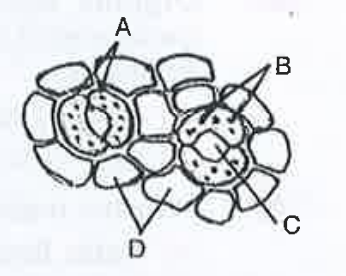CHECK YOUR GRASP from DINESH PUBLICATION ENGLISH TRANSPORT IN PLANTS for Class 12
| Class 12 | BIOLOGY |
| Chapter | TRANSPORT IN PLANTS |
| DINESH PUBLICATION ENGLISH | CHECK YOUR GRASP |
| Medium | English |
| Academic Year | 2023-2024 |
Question 300
Arrange root hair cell, inner cortical cell and mesophyll cell in ascending order of DPD.
(a) Mesophyll cell, Root hair cell and Cortical cell
(b) Cortical cell, Mesopphyll cell and Root hair
(c) Root hair cell , Cortical cell and Mesophyll cell
(d) Root hair cell, Mesophyll cell and Cortical cellView SolutionQuestion 371
Identify the correct statements and find out the correct combination ?
1. Accumulation of K+ ions in guard cells does not require energy
2. A high pH favours stomatal opening
3. Movemant of chloride ions into guard cells is in response to electrical differential created by K+ ions
4. With entry of several K+ions and chloride ions, water potential of guard cells increases .View SolutionQuestion 398
Which ones are true and false ? (a)Positive hydrostatic pressure is called turgor pressure (b) Wall pressure exerts to prevent the increase of protoplasm size(c) Diffusion is more rapid in liquid than in gases (d) Diffusion of water through a semipermeable membrane is called imbibition (e) Osmosis is movement of substances which takes place along a diffusion gradient View SolutionQuestion 406
Select the correct ones.
A-Apoplastic movement of water occurs exclusively through cell
wall.
B-Solution increase free energy of water or water potential.
C-Symplasric movement occurs through plasmodesmata.
D- Membrane permeability depends upon membrane composition
as well as chemical nature of solute View SolutionQuestion 416
Which of the following statement are not true
(a) In CAM plant,stomata open during dark and remain closed during day
(b) Role of Na+ in stomata opening is now universally accepted
(c) Water Potential of root cells is higher then water potential of soil
(d) Capillarity theory is most accepted theory theory of water movement through plants
(e) Wall of xylem vessels made up of lignocellulose has strong affinity for water molecules View SolutionQuestion 425
Study the following table showing the components of water potential in closely arrange mesophyll cells namely A, B and C
CellOsmotic Potential (MPa)Pressure Potential (MPa)A−0.210.05B−0.220.02C−0.230.05
Identify two of the following , which show the correct direction of water movement between two cells .
I.A→B.IIB→C
III.C→A.IVC→BView SolutionQuestion 442
Select the correct events leading to the opening of the stomata
(i) Decline in guard cell solutes
(ii) Lowering of osmotic potential of guard cells
(iii) Rise in potassium levels in guard cells
(iv) Movement of water from neighbouring cells into guard cells
(v) Guard cells becoming flaccidView SolutionQuestion 527
Find out the correct pair of statements (i) In completely plasmolysed cell, pressure potential does not contribute to water potential (ii) If a cell is placed in hypotonic solution for longer time , the cell membrane shrinks away from its cell wall (iii) Apoplastic system comprises interconected protoplasts (iv) Polypeptides have more imbibing capacity then polysaccharides View SolutionQuestion 541
Find the correct pair of statements
(i) Influx of Cl- into guard cells during stomatal opening is active.
(ii) Entry of sucrose from companion cells into sieve tubes at source involves expenditure of energy
(iii) At the sinks sucrose moves out of phloem by passive transport
(iv) Efflux of K+ from guard cells during stomatal closure does not involve energy expenditure View SolutionQuestion 553
X and Y are adjacent living cells. The cell X has solute potential (Ψs) of -9 bars and preesure potential (Ψp) of bars wherease cell Y has solute potential (Ψs) of -8 bars and pressure potential (Ψp) of 5 bars. What will be the direction of water movement between these cells View SolutionQuestion 571
Concrete is produced form a mixture of cement, water and small stones. Small amount of gypsum, CaSO4.2H2O is added in cement production to improve the subsequent hardening of concrete. The elevated temperature during the production of cement may lead to the formation of unwanted hemihydrate CaSO412H2O according to reaction.
CaSO42H2O(s)→CaSO412H2O(s)+32H2O(g)
The ΔfHΘofCaSO2.2H2O(s),CaSO412H2O(s),H2O(g)
are −2021.0kJmol−1,−1575.0kJmol−1 and −241.8kJmol−1, respectively. The respective values of their standard entropies are 194.0,130.0 and 188.0JK−1mol−1. The values of R=8.314JK−1mol−1=0.0831L bar mol−1K−1.
Answer the following questions on the basis of above information.
Heat change occurring during conversion of 1kg of CaSO4.2H2O(s) (molar mass 172gmol−1) of CaSO412H2O(s) is equal to View Solution









